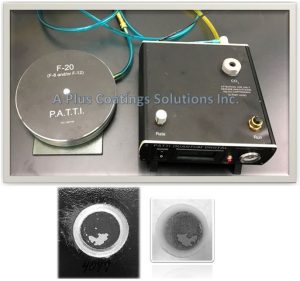For coatings to provide successful corrosion protection of steel, they must adhere to the substrates on which they are applied. Adhesion is the strength of the bonds forming between a coating and the underlying substrate. Failures related to adhesion will determine the life of a coating system.
Our coating laboratory testing service provides a variety of recognized methods for adhesion evaluation.
Pull-Off Adhesion
Pull-off adhesion testing gives a direct indication and provides quantitative adhesion values for the bonding strength of a coating to a substrate or the cohesion strength of the coating in a tension normal to the surface. The test is performed by securing loading fixtures (dollies or studs) perpendicular to the surface of coatings being tested with an adhesive. By use of a portable pull-off adhesion tester, a tensile stress is increasingly applied to the surface and monitored until either the loading fixture is detached or a specified load value is reached. Failure will occur along the weakest plane within the system comprised of the fixture, adhesive, coating system, and substrate. The pull-off strength is reported in pounds per square inch (psi) or mega Pascals (MPa).
Standard methods for pull-off adhesion test are available in ASTM D4541, ISO 4624, ASTM D7234, ISO 16276-1, and AS 1580.408.5, etc.

Tape Adhesion
The tape adhesion test uses pressure-sensitive tape to determine the adhesion quality of a coating. There are two variants of this test; the X-cut tape test and the cross hatch tape test.
- X-cut tape test: this test is performed by using a sharp knife or other cutting devices to make a 30 to 45 degree angle “X” through the coating to the substrate and applying a pressure-sensitive tape to the scribed area. The tape is placed on the center of the intersection of the cuts and then removed rapidly. Adhesion is evaluated by how much, if any, coating comes off with the tape. Adhesion is assessed on a 0 to 5 scale.
- Cross hatch tape test: this test is primarily intended for use in the laboratory on coatings less than 5 mils (125 microns) thick. A crosshatch pattern is made through the film to the substrate by using a cutting guide or a special cross-hatch cutter. After the tape has been applied and pulled off, the cut area is then inspected and rated on a 0 to 5 scale.
Standard methods for tape adhesion test are available in ASTM D3359, ISO 2409, and ISO 16276-2, etc.

Knife Adhesion
The knife adhesion test is qualitative and subjective, and its value depends upon the inspector’s experience. The test is done by making two intersecting scratches (X-cut or V-cut) through the coating to the substrate. The adhesion is then assessed by peeling the coating from the intersection point with a utility knife. Performance is based on both the degree of difficulty to remove the coating from the substrate and the size of removed coating.
Standard methods for knife adhesion test are available in ASTM D6677, ISO 21809-2 Section A.4, and ISO 21809-3 Annex C, etc.
Test Samples:
Coated steel panels
